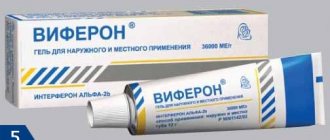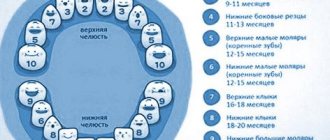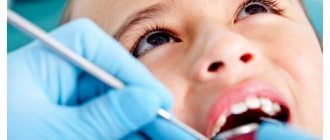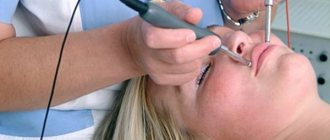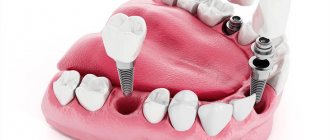A new advanced system of dental treatment for children - sedation - has become available at the Marina Kurchaninova Smile Dentistry Center. A system that has long been used by specialists from Europe and the USA.
The discoverer of nitrous oxide was the English scientist Joseph Priestley, who first synthesized this substance in 1772. However, the pain-relieving properties of nitrous oxide were discovered by another researcher, Humphry Davy. He also gave the name to the new substance – “laughing gas”. This name is completely true - when inhaling this gas, a person falls into a slight euphoria, a very pleasant state. In addition, his pain sensations (if any) disappear, as well as the ability to experience them for some time.
ZAKS began to be used in dental practice in 1948, and to date, about 80% of cases of treatment of children cannot be done without the use of this drug.
Basically, all pediatric dentistry technologies that are now widespread in Russia are aimed not at treatment, but at healing teeth. The current situation is quite understandable - this is all that can be done during the time until the child agrees to open his mouth.
Now dentists have a tool that helps them provide full treatment to young patients - sedation.
What is sedation, in short?
Sedation is a superficial sleep in which the patient can be awakened at any time. This method is aimed at calming the patient so that the specialist can carry out all the necessary dental procedures. Sedation is an excellent addition to traditional anesthesia and is carried out using special sedatives.
Each physician may have individual sedative preferences. However, throughout the world, the greatest respect has been earned by such a drug as nitrous oxide - oxygen sedation (NAS). It is a mixture of inert gas and oxygen, which has an indistinct sweetish odor. The use of the mixture ensures the most harmless and safe sedation.
The sedation procedure is simple: the patient puts on a mask and inhales ZAC. After which he has a feeling of calm and relaxation. Nitrous oxide is supplied using special equipment. Exhaled gases are immediately collected by high-speed suction.
The resulting state is reminiscent of the sensations that we experience on a summer day after rain, when an increased nitrogen content appears in the air. We experience a feeling of joy, pleasure and pleasant relaxation.
The effect of laughing gas is short-lived. Within just a few minutes it is completely cleared from the lungs. Laughing gas is completely safe - when taken, heart rate and blood pressure remain normal, and there is no addiction to it.
Treatment of children after sedation is quick, effective and, importantly, leaves pleasant memories for the children. The child is in a state of light anesthesia, but at the same time he is conscious and able to communicate normally with the doctor. The use of nitrous oxide greatly facilitates the process of dental treatment for both participants in the process - both the doctor and his little patient. In addition, children develop a positive attitude towards visiting the dentist, and this also makes life easier for their parents.
Children willingly put on bright masks and inhale the sweet aroma. Their use makes the procedure even more enjoyable for the child.
Sedation and anesthesia in the treatment of special children
When treating teeth in children with mental or physical developmental disabilities, both methods can be used.
Their choice is determined by an individual approach and depends on the child’s communication abilities. If he can communicate with the doctor and fulfill his requests, then sedation can be used. If communication is difficult or impossible, anesthesia is used. A preliminary diagnosis, tests, and detailed consultations with an anesthesiologist and pediatrician, and with the child’s attending physician are carried out. This is necessary for the safety of the procedure. At the clinic, parents will be helped to properly prepare their baby for treatment under anesthesia.
Although sedation is actively used in pediatric dentistry, adaptation and establishing trust between the child and the doctor is still the most important aspect of preparation for treatment. Sedation is a tool that relieves unpleasant emotions, and an adaptation technique allows you to permanently rid your child of the fear of treatment.
Published on the portal nnmama.ru
Benefits of using sedation in children
Therefore, we can say with confidence that the use of sedation has undeniable advantages. Among the advantages of the method are the following:
- The use of ZAX (nitrous oxide - oxygen sedation) makes dental treatment painless;
- The child does not experience psychological discomfort in the doctor’s office: in a state of sedative anesthesia, he does not smell unpleasant odors, does not hear the frightening sound of a drill, and does not distinguish between medical instruments;
- The use of ZAX removes tactile sensitivity, so the baby will not be frightened by vibrations, pressure, compression, etc., made by the doctor;
- The doctor is able to provide full treatment, because his access to the patient is no longer hampered. Now the dentist has enough time to apply the most effective modern treatment methods. He can also use any preparations, even those that harden for a long time;
- The risk of complications after dental treatment is reduced.
The use of sedation has ushered in a new era in pediatric dentistry. After all, doctors now have the opportunity to use modern composite materials for treatment. And they are more durable, hygienic and aesthetically pleasing compared to those previously used. Until recently, composite materials were not used for the reason that their placement requires careful drying of the tooth. The doctor must also wait a long time for the material and fixing glue to harden. Now he has the necessary time reserve.
How is sedation performed during dental treatment?
The sequence of actions during dental treatment under sedation is as follows: first, the doctor puts the child into a state of sedation, then makes an anesthetic application at the injection site with a special gel.
This is necessary to completely eliminate any discomfort in the baby. The dentist then administers an anesthetic and then begins treatment. Sedation in pediatric dentistry is most often performed using nitrous oxide mixed with oxygen, which is administered through a nasal mask. Oxygen comes in first, then a very small amount of nitrous oxide. This is a sweetish inert gas that begins to act in 2-3 minutes and is completely eliminated from the child’s body within 10 minutes after stopping the supply of the mixture.
Nitrous oxide is completely harmless to the child - to date, not a single case of complications after sedation has been described.
That is why it is so widely used in pediatric dentistry. Nausea or vomiting is very rare, but to prevent these phenomena, the doctor removes the child from sedation gradually, over 5 minutes.
However, sedation or anesthesia does not exclude the need for an adaptation technique. This is a method of working with children in which a friendly, trusting relationship is established between the dentist and the child. The doctor shows the little patient the office, the instruments, the mask and the sedation machine, and explains what it is for. This way the child stops being afraid of the new environment, and the doctor’s actions become clear to him. This reduces the baby's stress and anxiety levels.
How to prepare for the sedation procedure?
It is necessary to strictly adhere to the recommendations given by the doctor, namely:
Before performing drug sedation, it is necessary to do a general blood test, coagulogram, ECG, biochemical blood test, tests for HIV, HCV, HbsAg, Rw. These studies are required for the safety of the patient himself. General preparation for the procedure is usually carried out directly in the dental clinic itself. Patients are advised to refrain from eating and drinking 4 hours before the procedure.
The doctor should be aware of whether the child has respiratory problems, in particular whether he has difficulty breathing through his nose. In the case of such diseases, the sedation procedure loses its effectiveness to some extent. Be sure to tell the dentist what medications your child took on the day of the clinic visit.
STORIES
Content
Many children are afraid to have their teeth treated. And besides, sometimes you have to treat several teeth at once. The process may not be quick and it will be physically difficult for the child to sit quietly in a chair for more than 15 minutes. Therefore, treatment under sedation is ideal for children. The latest equipment and the professionalism of our doctors - pediatric dentist Tatyana Vladimirovna Ermakova and anesthesiologist Oleg Stanislavovich Markov - allow us to perform all the necessary procedures quickly and without pain, as well as provide the psychological comfort that is so necessary for young patients.
Sedation scheme
The patient puts on a mask, and 100% oxygen first enters his lungs. The oxygen mass is supplied at a speed of 4-6 liters per minute. Nitrogen is gradually mixed with oxygen. Its content is increased to 30%. When the proportions of nitrogen and oxygen are brought to a ratio of 30 to 70, respectively, the moment comes favorable for starting treatment. However, it should be noted that the concentration of nitrous oxide may vary depending on the individual patient. It is important to achieve the desired effect, and it, in turn, can occur with a different ratio of nitrogen and oxygen. Individual indicators are recorded in the patient's record.
The blood is saturated with gas in about 5-7 minutes. Nitrous oxide is completely dissolved in blood serum and is not biotransformed in any way. As soon as the supply of ZAX stops, the process of removing gas from the lungs begins. The gas is removed completely unchanged.
ZAX differs from other sedatives in that the sedative effect occurs very quickly, and the trace effect is completely absent. This is caused by nonspecific depression of the central nervous system.
Sedation manifests itself as follows: a comfortable and relaxed state; good, elevated mood; movements are inhibited; deep breathing; motor activity of the eyes is reduced; sound perception is dull; resistance is reduced.
If you plan to undergo a particularly painful procedure, you can temporarily increase the concentration of nitrous oxide to 50% (acceptable limit is 70%). Nitrous oxide has an analgesic effect, and also enhances the effect of local anesthetics. If the child is suddenly frightened and painful sensations begin to “reach” him, manipulation with nitrous oxide will quickly calm the baby down and treatment can be continued.
Thus, the use of ZAX makes it possible to carry out treatment of any complexity in just one visit.
As for removing the patient from the state of sedation, it occurs smoothly and consists of supplying 100% oxygen for 5-10 minutes. At this time, the doctor communicates with the child, trying to reinforce his positive impressions of visiting the dental office.
In general, the successful use of ZAX is impossible without the competent use of behavior management techniques. Trying on a mask by a child should be done in a playful way so that the child has time to relax before the onset of sedation. The doctor calms the child by telling him about the condition he will soon find himself in. You cannot force a mask on, as this may cast doubt on the success of the procedure.
What to choose for dental treatment for a child: sedation or anesthesia?
Some people confuse sedation with anesthesia, because in addition to superficial sedation, in which the patient is fully conscious, there is also deep sedation, when the patient is put into medicated sleep. But this is where the similarities with anesthesia end.
Anesthesia does not just mean falling asleep, it also suppresses a number of reflexes and has an analgesic effect. During sedation (even deep), both reflexes and pain sensitivity are completely preserved, so sedation must be supplemented with painkillers, otherwise the patient may wake up from pain at the most inopportune moment.
Children also undergo dental operations under anesthesia, but this happens quite rarely; special indications for this are required, as well as detailed tests and careful observation by an anesthesiologist, special equipment and permits. Therefore, anesthesia is not performed in every clinic, and sedation is performed in many. For deep sedation, the drug is administered through an intravenous catheter, and for standard use through a special mask (nitrous oxide).
Is sedation with ZAX safe?
Yes, it's safe. ZAX is completely harmless for children. Moreover, today it can be called the safest sedative. It is easy to use, is eliminated from the body without a trace, does not have a heavy or overly strong effect, and is not addictive. The child remains conscious, his breathing is not difficult, all reflexes are preserved. The use of ZACS ensures maximum safety, complete controllability and early activation of the patient.
You may have doubts about how well this technology has been tested. Despite the fact that it represents an innovation for Russia, ZAX sedation has long been used throughout the world (more than 30 years). The vast majority of pediatric dental clinics in the USA, Israel and the UK use ZAX as the main sedative. Thus, this technology can only be called new conditionally - it has long been tested and approved by professionals.
How is nitrous oxide used in dentistry?
Nitrous oxide, or laughing gas, as it is popularly called, was invented at the end of the 18th century by physicist John Priestley. For a long time, the invention could not be used: the gas with a pronounced sweetish taste was absolutely useless at first glance, but had a number of interesting properties. After inhalation, the person became cheerful, relaxed and experienced a feeling similar to intoxication. As usually happens, fans of this gas, or rather, its effects, quickly appeared. Nitrous oxide was used by clowns and circus performers to further excite and make the audience laugh. Over time, another interesting property was discovered: while under the influence of laughing gas, people did not seem to feel pain and treated it quite calmly. Dentist Horace Wells was the first to use nitrous oxide in dental treatment. Despite the fact that the first experiments gave positive results, public experiments were unsuccessful, and in one case the patient almost died. His colleague Wells Morton was more successful in using nitrous oxide, so he is considered a pioneer in this field. Of course, in the past, the gas formula and dosage were far from perfect, so treatment with nitrous oxide was not so predictable. In its modern version, sedation with nitrous oxide has been carried out since the late 40s. It was then that doctors began adding oxygen to the mixture and using special devices, including cylinders, a rotameter and a mask.
Differences between sedation and general anesthesia
1) The occurrence of coughing, swallowing and other reflexes is excluded, which in turn allows for complete dental safety.
2) The dentist can fully control the patient’s condition, since he is conscious throughout the entire procedure. Another advantage of the action of sedatives is the fact that a person under its influence can be taken out of a state of superficial sleep at any time.
3) The patient is in a relaxed state and can communicate with the doctor.
Very often, due to anxiety, a person cannot clearly formulate his problem, and the patient’s internal tension can complicate treatment. Sedation makes it possible to relieve emotional stress without causing harm to the body. Also, when a person experiences psychological stress, hemodynamic changes occur. High blood pressure and rapid heartbeat force the attending physician to make certain changes to the given treatment regimen.
Reviews
Natadent Clinic
– one of the few
pediatric dentistry in Northwestern Administrative Okrug
that actively uses
nitrous
in dental treatment for children.
This practice is widespread in Europe, the USA and Israel, but in Russia there are still few such clinics (even in Moscow,
not everyone uses sedation).
By contacting us, you can be sure that your child’s teeth will be treated with high quality, and he will experience a minimum of discomfort and will henceforth want to be treated only with us. You can read the reviews to make sure that our little patients and their parents always leave us happy.
LEAVE FEEDBACKRecommendations for using sedation
In dentistry, this method is used if the patient wishes, when he wants to receive the most comfortable and safe treatment. Dental specialists recommend resorting to drug sedation in cases that require the patient to remain in the dental chair for a long time. This may include surgical manipulation of the maxillary sinuses and other long-term operations.
Sedation is very convenient during orthopedic procedures, which can last up to 12 hours and involve putting the patient into a sleep state. In case of diseases of the cardiovascular system, psychiatric and allergic reactions, the possibility of using sedatives is discussed individually in order to avoid undesirable manifestations.
Modern specialists are actively finding the use of drug sedation in the field of prosthetics, implantology and surgical dentistry. Sedatives are widely used because they are absolutely safe and do not have a narcotic effect on the body and are not addictive. The great advantage of using sedation in dentistry is the parallel use of the necessary equipment and a special cardiac monitor, with which it is possible to monitor the patient’s condition, which almost completely eliminates any complication.
Indications and contraindications for sedative dental treatment in children
Typically, indications for sedation are hyperactivity, the child’s fear of doctors (especially when there has already been a previous negative experience of treatment), and the need for long-term treatment (for example, several teeth). But today, more and more people are choosing treatment under sedation, even if it’s just professional teeth cleaning.
Treatment under sedation is contraindicated for children only in certain cases:
- under the age of 3 years, since the patient must maintain verbal contact with the doctor,
- in the presence of respiratory diseases - with nasal congestion, it is extremely difficult to breathe through the nose, and the effect of nitrous oxide is greatly weakened,
- recent traumatic brain injury (in the previous 3 months),
- chronic otitis (especially in the acute stage),
- neurological diseases and seizure syndrome,
- the patient has epilepsy.
The last contraindication, unfortunately, is absolute. Nitrous oxide can increase intracranial pressure in such patients and provoke an attack. Sedation is also not used for patients in a state of panic fear - if the child is already hysterical, sedation will not help.
WHEN IS SEDATION TREATMENT RECOMMENDED?
Dental treatment with sedation for adults is recommended if the patient has a phobia, fear of pain.
A child’s first visit to the dentist for treatment is often carried out using this technique, so that in the future the child can trust the doctor and relax. This forms a positive image of the dentist in the child.
Sedation also copes well with an increased gag reflex and is very helpful if long-term treatment or complex removal is required.
Information about nitrous oxide-oxygen sedation on the official website of the ADA (American Dental Association)
Sedation is absolutely safe if all protocols for use are followed. If you compare this type of relaxation with a regular anesthesia injection, sedation is even safer for the patient!
There is a myth that the effect of sedation is equivalent to a drug, but this is not true! Nitric acid sedation is not addictive! There are no restrictions on the use of nitrous oxide; you can use this type of treatment at least every day, but only according to indications!
Treatment with sedation at the Istok Health Clinic is carried out under the supervision of an anesthesiologist in compliance with all protocols of use.
